In the ever-evolving landscape of therapy and rehabilitation, the integration of virtual rehabilitation has sparked significant debate. The research article "Will virtual rehabilitation replace clinicians: a contemporary debate about technological versus human obsolescence" provides a comprehensive analysis of this question. Here, we distill the key insights and actionable strategies for practitioners to enhance their skills and stay ahead in this dynamic field.
Understanding the Debate
The article is based on a debate held at the International Conference on Virtual Rehabilitation (ICVR) 2019. The central question was whether virtual rehabilitation could replace human clinicians. The discussion explored both the potential benefits and limitations of this technology.
The "Yes" Side: Embracing Technological Advancements
Advocates for virtual rehabilitation argue that:
- Increased Accessibility: Virtual rehabilitation can reach remote areas, making therapy accessible to those who might otherwise be underserved.
- Cost-Effectiveness: It can reduce costs associated with traditional therapy, making it more affordable for patients.
- Enhanced Tracking: VR allows for precise tracking of patient progress, enabling more tailored and effective treatment plans.
- Motivation and Engagement: The immersive nature of VR can make therapy sessions more engaging and enjoyable for patients, potentially improving adherence to treatment plans.
The "No" Side: The Irreplaceable Human Touch
Critics argue that:
- Personalization: Human clinicians provide a level of personalized care and empathy that technology cannot replicate.
- Therapeutic Alliance: The bond between clinician and patient is crucial for successful outcomes, something that VR cannot fully replicate.
- Complex Decision-Making: Clinicians make nuanced decisions based on a wide array of factors, including emotional and psychological states, which are challenging for AI to accurately assess.
- Safety Concerns: Issues like cybersickness and the need for real-time intervention in emergencies highlight the importance of human oversight.
Actionable Strategies for Practitioners
Given the mixed perspectives, here are some strategies for practitioners to enhance their skills and integrate virtual rehabilitation effectively:
1. Embrace Continuous Learning
Stay updated with the latest advancements in virtual rehabilitation technology. Participate in workshops, webinars, and courses that focus on the integration of VR in therapy.
2. Foster Technological Competence
Develop a strong understanding of the technological tools available. This includes knowing how to set up and troubleshoot VR systems, as well as understanding the data these systems generate.
3. Blend Human and Technological Approaches
Use VR as a supplement to, rather than a replacement for, traditional therapy. Leverage the strengths of both approaches to provide a more comprehensive treatment plan.
4. Focus on Patient Education
Educate patients and their families about the benefits and limitations of virtual rehabilitation. Address any concerns they might have about the technology to build trust and encourage acceptance.
5. Advocate for Ethical and Safe Practices
Ensure that any virtual rehabilitation program you implement adheres to the highest standards of safety and ethics. This includes being prepared to intervene in case of any adverse reactions or technical failures.
Encouraging Further Research
The debate around virtual rehabilitation is far from settled. Practitioners are encouraged to engage in ongoing research to explore the full potential and limitations of this technology. Collaborate with researchers, participate in clinical trials, and contribute to the growing body of evidence in this field.To read the original research paper, please follow this link:
Will virtual rehabilitation replace clinicians: a contemporary debate about technological versus human obsolescence.










